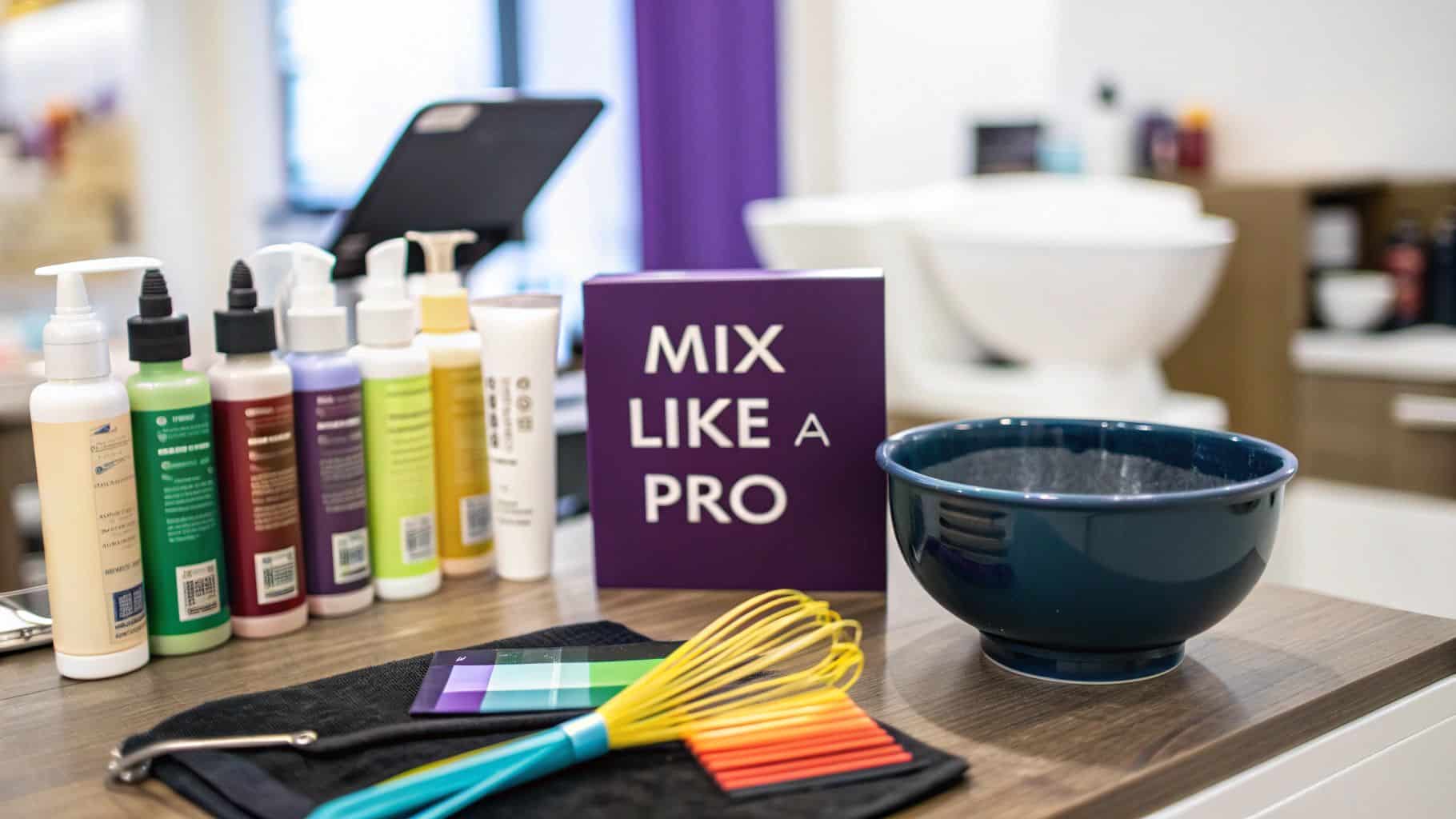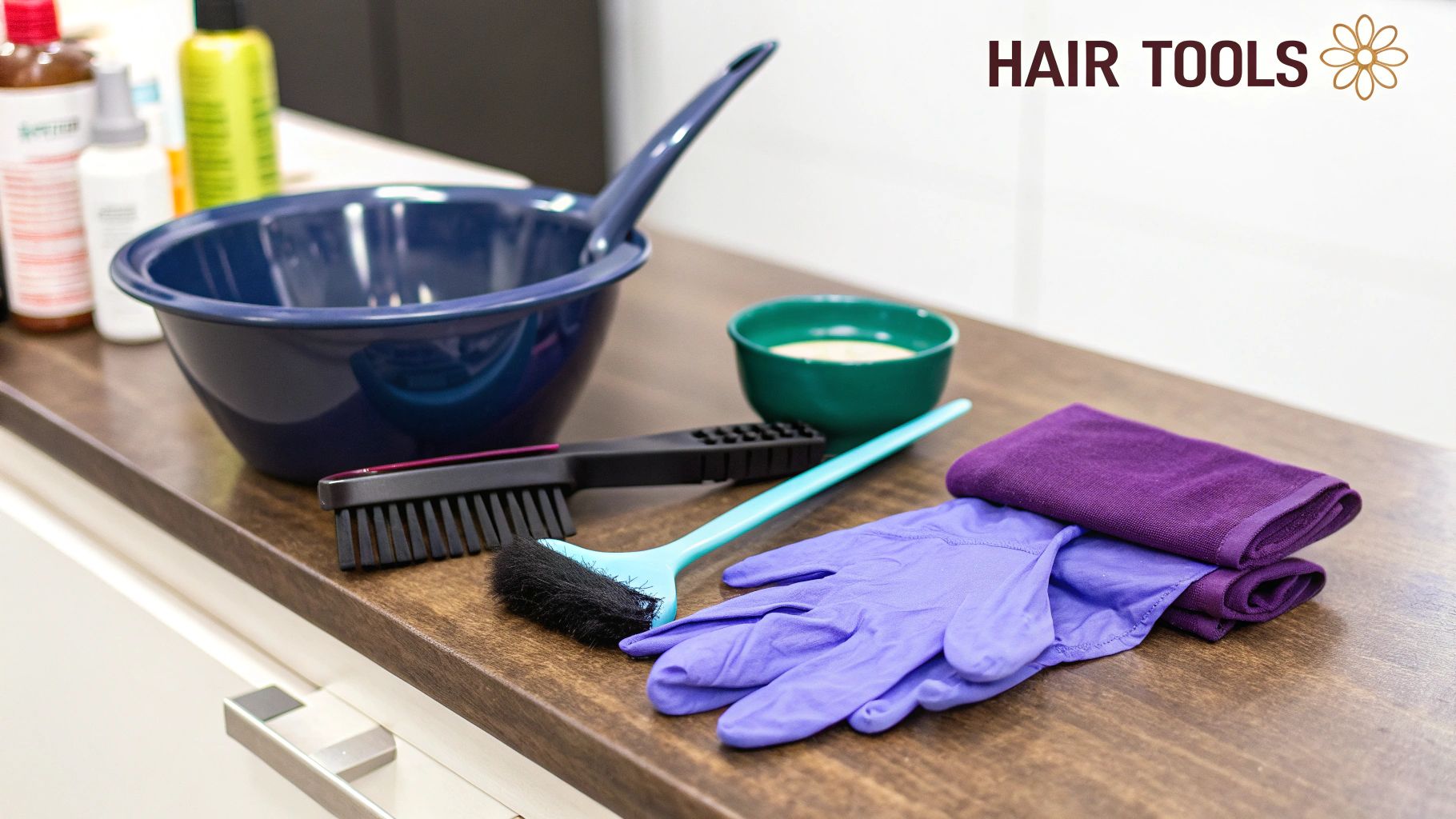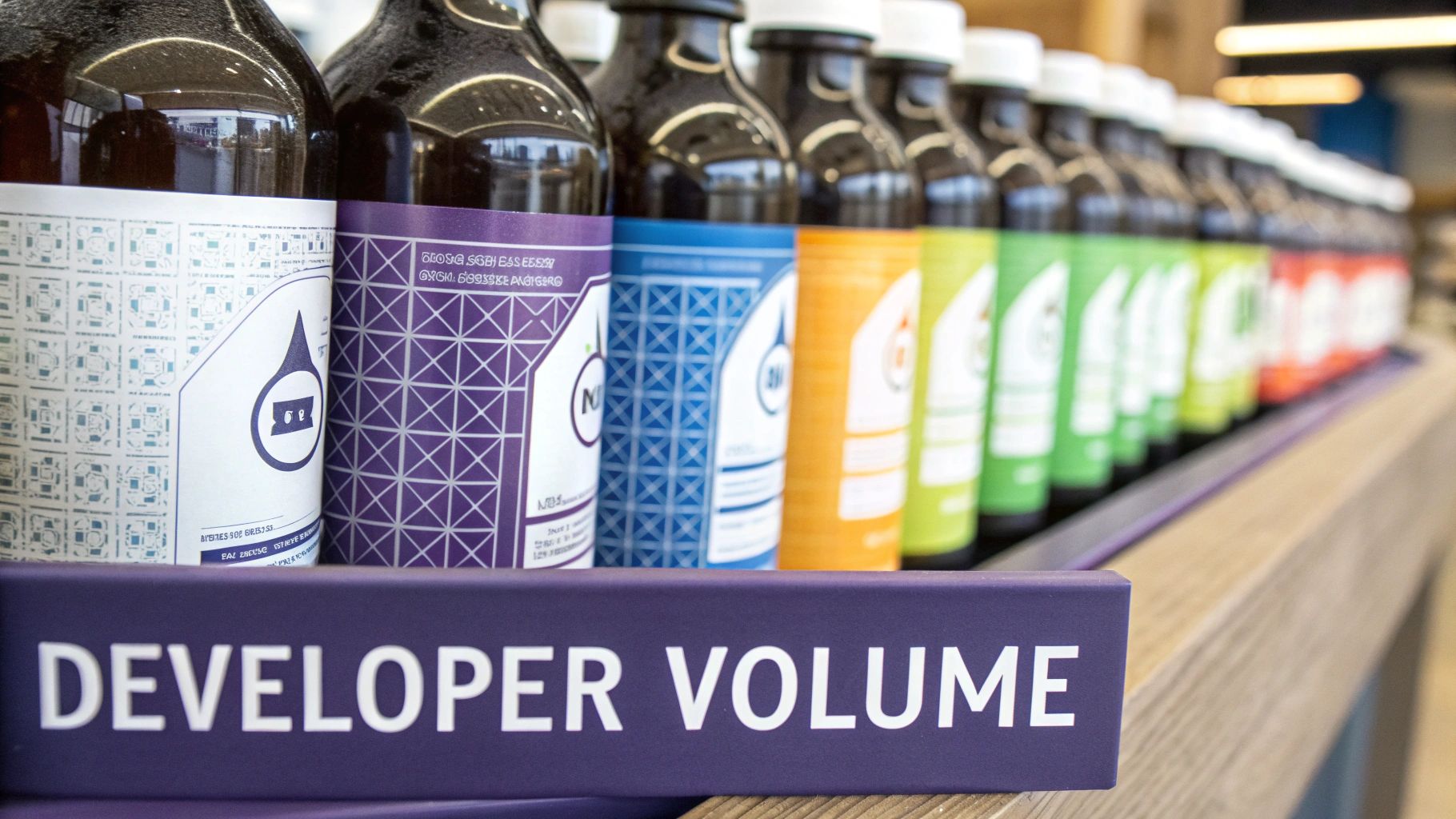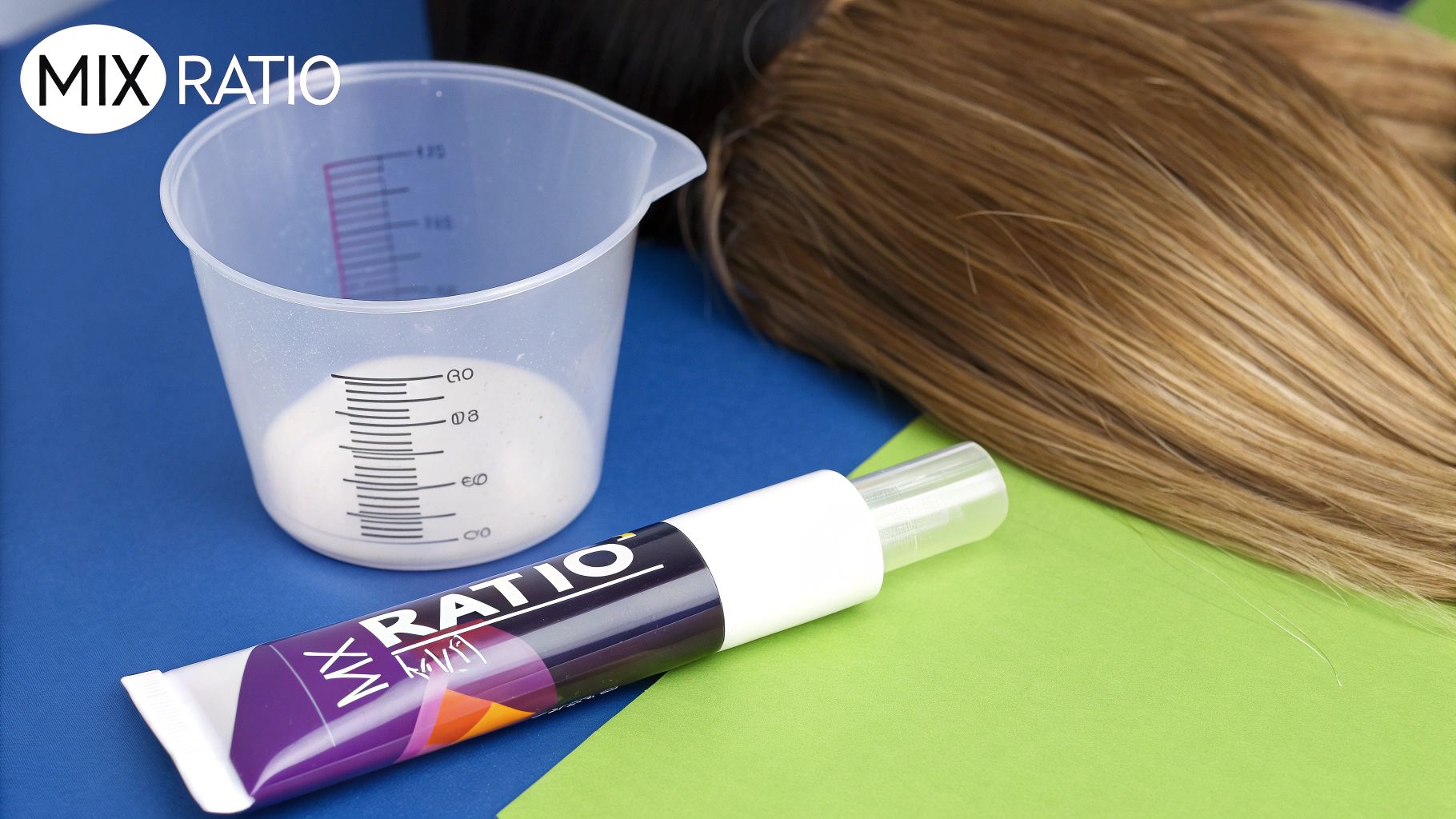How to Mix Hair Color and Developer Like a Pro

Mixing hair color and developer is a core skill for any salon professional, and mastering it starts with one simple rule: a 1:2 ratio.
This industry-standard formula means for every one part of hair color, you'll use two parts of developer. For example, if your service requires 2 ounces of color, you will mix it with 4 ounces of developer. Following this foundational ratio is your first step to delivering consistent lift, vibrant color, and predictable results that keep your clients happy.
The Foundation of Flawless Hair Color

Executing a perfect color mix is the single most important step for achieving professional, repeatable results in your salon. When the ratio is correct, the chemical process activates exactly as intended, giving you full control over the final outcome. Think of it as the blueprint for every color service you perform.
The standard starting point is that 1:2 ratio of dye to developer. A stylist using 2 ounces of hair color would mix it with 4 ounces of 20 volume developer to ensure proper activation and coverage. However, your professional judgment is key. A client with short, fine hair might only need a 1:1 mix for gray coverage, while another with long, thick hair may require a 1:2.5 mixture to achieve the necessary lift.
Mastering your mixing ratios elevates your service from a simple application to a customized chemical treatment. This precision builds client trust and is a key differentiator that sets your salon business apart from the competition.
Why Ratios Are Just Your Starting Point
While the 1:2 ratio is a reliable industry standard, treat it as a flexible guideline, not a rigid rule. This mindset empowers you to create a custom formula for every client, ensuring optimal results based on their specific needs.
Here are the key factors that will require you to adjust your mix:
- Desired Lift: To achieve a lighter result for a client, a higher developer ratio, such as 1:2, is necessary to increase the lifting power.
- Gray Coverage: For resistant grays, you need maximum pigment deposit. A more concentrated color ratio, like 1:1, provides the opacity needed for full coverage.
- Hair Texture: Coarse hair has a resistant cuticle that requires a stronger mix to penetrate effectively. Fine hair, on the other hand, processes more easily and may benefit from a gentler formula.
Understanding why you are selecting a specific ratio is a hallmark of an expert colorist. This knowledge boosts your confidence and allows you to troubleshoot potential issues before they arise. Showcasing this expertise is also a powerful business tool—learn how to market these skills in our guide to hair salon social media.
Quick Reference Mixing Ratios
To streamline your process at the color bar, use this table as a quick reference for the most common mixing ratios and their primary business applications.
| Ratio (Color:Developer) | Primary Use Case | Expected Result |
|---|---|---|
| 1:1 | Maximum gray coverage, deposit-only color | Deep, opaque color with minimal to no lift |
| 1:1.5 | Standard coloring, balancing deposit and lift | Balanced color result with up to 1-2 levels of lift |
| 1:2 | High-lift coloring, lightening, toning | Maximum lift (up to 4 levels), sheer toning results |
| 1:2.5 | Very coarse or resistant hair requiring more lift | Extra lightening power for thick or hard-to-lift hair |
This table serves as an excellent starting point, but always consult the manufacturer's instructions for your specific color line. Every brand has unique formulations, and following their guidelines is the best practice for guaranteeing flawless, consistent results.
Choosing the Right Developer Volume

Think of developer volume as the engine that powers your hair color formula. It controls the amount of lift you achieve, and selecting the correct strength is critical for protecting hair integrity while achieving the target shade. Each volume has a specific function, making this a strategic choice, not just a matter of habit.
Your choice of developer is as crucial as your mixing ratio. Strengths range from 10 volume (3% peroxide) to 40 volume (12% peroxide), with each designed for a different outcome. Using the wrong developer is a leading cause of hair damage and unpredictable color results. For a deeper look at this topic, Zotos Professional offers a helpful guide on choosing the right hair color developer.
Connecting Developer Volume to Client Scenarios
To make strategic decisions behind the chair, connect each developer volume to the real-world client scenarios you manage daily. This ensures every choice is intentional and customized.
-
10 Volume Developer
This is your tool for deposit-only services. Use 10 volume when you need to add depth, darken a shade, or tone pre-lightened hair without lifting the natural pigment.
Actionable Insight: Perfect for glossing services or refreshing faded ends. -
20 Volume Developer
The salon workhorse. 20 volume is the standard for reliable gray coverage and achieving 1-2 levels of lift.
Actionable Insight: Your go-to for clients who want to cover grays while staying close to their natural color level. -
30 Volume Developer
When a client desires a more significant change, 30 volume provides 2-3 levels of lift.
Actionable Insight: Ideal for creating vibrant reds or achieving brighter blonde results, especially on darker natural hair. -
40 Volume Developer
Reserve 40 volume for high-lift applications on coarse, dark, and exceptionally healthy hair.
Actionable Insight: Use this with extreme caution and constant monitoring to prevent compromising the hair's integrity. Best for experienced stylists performing controlled lightening services.
Choosing the correct developer is a critical part of the client consultation. Explaining why you're selecting a specific volume showcases your expertise and builds trust. This transforms a standard service into a personalized experience and is a cornerstone of building a loyal client base for your business.
Your Professional Mixing Technique
A precise color formula is not just a recommendation—it's the key to delivering consistent, professional results that drive client retention. Precision is non-negotiable for a successful salon business.
To start, gather your essential tools: a non-metallic bowl, a color whisk, and a digital scale. Avoid using measuring cups or estimating by eye. Measuring your formula by weight is the only method that guarantees accuracy every time. This is the foundation of mixing hair color and developer like a true professional.
Here is an actionable tip to improve efficiency and reduce mess: pour your developer into the bowl before adding the color. This simple change helps the ingredients blend faster and prevents color from sticking to the bottom of the bowl. Whisk the mixture until it reaches a smooth, creamy consistency, similar to yogurt or pudding. Ensure there are no lumps.
A perfectly uniform mixture is essential for an even application. It prevents splotches or color bands that signal an amateur result. This attention to detail is what distinguishes a novice from an expert colorist and guarantees a premium service every time.
Mastering the Mixing Process
The image below outlines the core steps to achieve the perfect mix. Use it as a quick reference during busy days in the salon.

The process is built on three actionable pillars: measure accurately, combine thoroughly, and stir until perfectly smooth.
This principle of precise measurement and blending is critical not just for hair color, but also for similar at-home chemical treatments like Japanese hair straightening, where errors can cause significant damage.
Business Insight: The final consistency of your mixture directly impacts its application and performance. A formula that is too thin will drip, creating bleed marks and potential messes. A formula that is too thick or lumpy will be difficult to apply evenly, leading to inconsistent color. Aim for that perfect, creamy texture to ensure a professional and efficient application.
How Mixing Ratios Shape Your Final Color

This is where you transition from a technician to a true color artist. Your mixing ratio is the control dial for both lift and pigment deposit, allowing you to customize every color service beyond a one-size-fits-all approach.
Ratios in Real-World Scenarios
A thicker, more pigment-dense 1:1 ratio is your solution for challenging gray coverage clients. This mix delivers the maximum amount of pigment for a rich, opaque result that completely covers stubborn grays. When your goal is depth and intensity, this is the formula to use.
Conversely, a 1:2 ratio is designed for lightening. With double the developer, the color pigment is diluted, which increases the formula's lifting power. This makes it the ideal choice for clients seeking to go lighter and brighter while still achieving a beautifully toned finish.
Here is how to apply these ratios to common client requests in your salon:
-
The Gray Coverage Client: A client presents with over 50% gray hair and requests a deep, solid brunette. Your Action: Mix a 1:1 ratio to ensure every gray strand is fully saturated, delivering a flawless, uniform finish.
-
The Blonde Ambition Client: A client with dark blonde hair wants to achieve a light, cool ash blonde. Your Action: A 1:2 mix is your go-to. It provides the necessary lift to break through their natural base while depositing the delicate ash tones required for a cool result.
The ratio you select directly influences color intensity, lift, and coverage on resistant hair. While a 1:1 mix is best for depositing rich color with minimal lift, increasing the developer to a 1:1.5 or 1:2 ratio can achieve one or two levels of lift. For more insights, you can review this guide on measuring color and developer on glossgenius.com.
Business Insight: Understanding the 'why' behind each ratio is a game-changer for your business. It enables you to predict results, troubleshoot issues proactively, and customize formulas with confidence. This is the skill that builds unwavering client loyalty and makes your salon stand out.
Common Mixing Mistakes and How to Fix Them
Every experienced colorist has faced a color correction, and most of these challenges begin with a preventable mistake at the mixing station. By implementing standardized procedures, you can run a more efficient and profitable salon.
The most common error is "eyeballing" measurements instead of using a digital scale. This practice leads to inconsistent color, poor gray coverage, and unpredictable lift. The solution is simple: always measure by weight, not volume. This non-negotiable step guarantees precision for every single mix.
Another frequent mistake is using the wrong tools. Metal bowls or whisks can cause premature oxidation of the hair color, altering the final shade in unexpected ways. The fix is to use only professional, non-metallic tools (plastic or glass bowls and whisks).
Preventing That Splotchy, Uneven Look
Finally, under-mixing is a silent killer of a perfect color service. A lumpy formula will not apply evenly, resulting in splotchy patches and color bands that require a corrective service. Whisk every formula until it is completely smooth and creamy.
Making these simple practices a standard operating procedure in your salon will dramatically reduce your error rate. This isn't just about saving money on wasted product or complimentary corrections; it's about ensuring every client leaves completely satisfied with their result. Highlighting this commitment to precision is an excellent detail to include in your professional hair salon service descriptions, as it signals a high standard of quality to potential clients.
Actionable Insight: Treat your mixing station as your quality control center. A perfect mix is the foundation of a flawless color service. Investing a few extra seconds to measure accurately and blend thoroughly will save you hours of stressful (and unpaid) correction work later.
Your Top Hair Color Mixing Questions, Answered
Even seasoned stylists encounter questions at the color bar. Understanding the chemistry behind your formulas is key to mixing with confidence. Here are direct, actionable answers to common questions to help your team handle any situation.
Mastering these fundamentals is essential for delivering high-quality color services that build your business. It is just as critical as your marketing strategy, which is why having solid hair salon marketing ideas and flawless technical skills go hand-in-hand.
What Happens If I Add Too Much Developer?
Adding too much developer dilutes the color pigment, which results in a sheerer, weaker color than intended. The final shade may appear too light or brassy because the formula's lifting power has been increased while its pigment-depositing ability has been weakened.
Furthermore, the mixture will become thin and runny, making it difficult to control during application. This increases the risk of drips, splotches, and color bleeding, leading to an unprofessional result.
Can I Use a Different Brand of Developer?
While it may be tempting in a pinch, it is a business best practice to avoid this. Professional hair color lines are formulated as complete systems, meaning the color and developer from the same brand are designed to work together synergistically.
Mixing brands introduces unpredictable variables that can affect the formula's pH balance, stability, processing time, and final color result. To guarantee consistent, reliable, and professional outcomes for your clients, always use the color and developer from the same manufacturer.
How Long Does Mixed Color Last Before Use?
The oxidation process begins the moment you combine hair color and developer. From that point on, the formula's potency starts to decrease.
For best results, you must apply the mixture to the hair immediately. Most color formulas become significantly less effective after 30-60 minutes. Using an old mix will result in patchy coverage, uneven lift, and a dull finish. Never save a leftover mixture for a future appointment—it is both ineffective and unprofessional.
Does the Mixing Order Matter?
Yes, for maximum efficiency and a smoother blend, the order matters. The industry best practice is to measure and pour your developer into the non-metallic bowl first, then add your hair color.
This simple, actionable step prevents the thick color cream from sticking to the bowl, making it significantly easier and faster to whisk everything into a smooth consistency. Adopting this practice will save time and effort during every color service.
Ready to showcase your salon's expertise with a website that works as hard as you do? At gohappybeauty, we build stunning, SEO-optimized websites specifically for beauty professionals. Attract more clients and grow your business online by visiting us at https://gohappybeauty.com.
Grow your beauty business
Our focus is, and always will be, helping you improve your online presence and generate more business from your website. That is what we do, for you.

